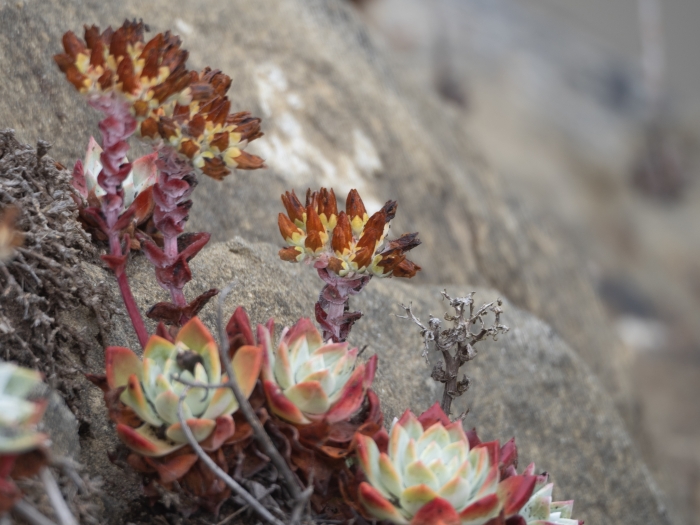Powdery Liveforever
(Dudleya farinosa)
Powdery Liveforever (Dudleya farinosa)
/
/

Karen and Mike
CC BY 4.0
Image By:
Karen and Mike
Recorded By:
Copyright:
CC BY 4.0
Copyright Notice:
Photo by: Karen and Mike | License Type: CC BY 4.0 | License URL: http://creativecommons.org/licenses/by/4.0/ | Rights Holder: Karen and Mike | Publisher: iNaturalist | Date Created: 2021-08-08T10:29:16-07:00 |




















































Estimated Native Range
Summary
Dudleya farinosa, commonly known as Powdery Liveforever, is an evergreen perennial succulent native to coastal bluffs, rocky outcrops, and chaparral of California and Oregon. It typically grows to a height of 1 foot (0.3 meters) and a width of 3-4 feet (0.9-1.2 meters). This species forms a basal rosette of wide, pointed, spade-shaped leaves, each up to about six centimeters across. The leaves are coated with a powdery bloom, giving them a distinctive chalky appearance that can range from pale green to bluish-gray, often with edges or tips highlighted in bright colors, particularly reds. Dudleya farinosa produces a tall, pale green stem with pink or red tinting, topped by a branching inflorescence with numerous pale to bright yellow flowers that are quite showy, blooming in spring through fall.
Powdery Liveforever is valued for its drought tolerance and striking foliage, which adds a unique texture and color contrast to rock gardens, succulent collections, and coastal landscapes. It is often used in xeriscaping and as a ground cover in areas with minimal water availability. In cultivation, it requires full sun to part shade, very low water once established, and well-draining soil to prevent root rot. While generally low-maintenance, it can be susceptible to aphids and mealybugs, and overwatering can lead to fungal diseases. It is important to avoid wetting the leaves when irrigating. Dudleya farinosa is not known for aggressive roots or significant invasiveness, but it should be protected from snails and slugs which may damage the foliage.CC BY-SA 4.0
Powdery Liveforever is valued for its drought tolerance and striking foliage, which adds a unique texture and color contrast to rock gardens, succulent collections, and coastal landscapes. It is often used in xeriscaping and as a ground cover in areas with minimal water availability. In cultivation, it requires full sun to part shade, very low water once established, and well-draining soil to prevent root rot. While generally low-maintenance, it can be susceptible to aphids and mealybugs, and overwatering can lead to fungal diseases. It is important to avoid wetting the leaves when irrigating. Dudleya farinosa is not known for aggressive roots or significant invasiveness, but it should be protected from snails and slugs which may damage the foliage.CC BY-SA 4.0
Plant Description
- Plant Type: Herb, Succulent
- Height: 0.5-1 feet
- Width: 0.5-1 feet
- Growth Rate: Slow, Moderate
- Flower Color: Yellow
- Flowering Season: Spring, Summer
- Leaf Retention: Evergreen
Growth Requirements
- Sun: Full Sun, Part Shade
- Water: Very Low
- Drainage: Fast
Common Uses
Bee Garden, Bird Garden, Butterfly Garden, Drought Tolerant, Fire Resistant, Groundcover, Hummingbird Garden, Low Maintenance, Potted Plant, Rock Garden, Salt Tolerant
Natural Habitat
Native to coastal bluffs, rocky outcrops, and chaparral of California and Oregon
Other Names
Common Names: Bluff Lettuce, Powdery Dudleya
Scientific Names: , Dudleya farinosa, Dudleya compacta, Cotyledon farinosa, Dudleya septentrionalis, Dudleya eastwoodiae, Cotyledon compacta, Cotyledon eastwoodiae, Cotyledon farinulenta, Cotyledon septentrionalis
GBIF Accepted Name: Dudleya farinosa (Lindl.) Britton & Rose